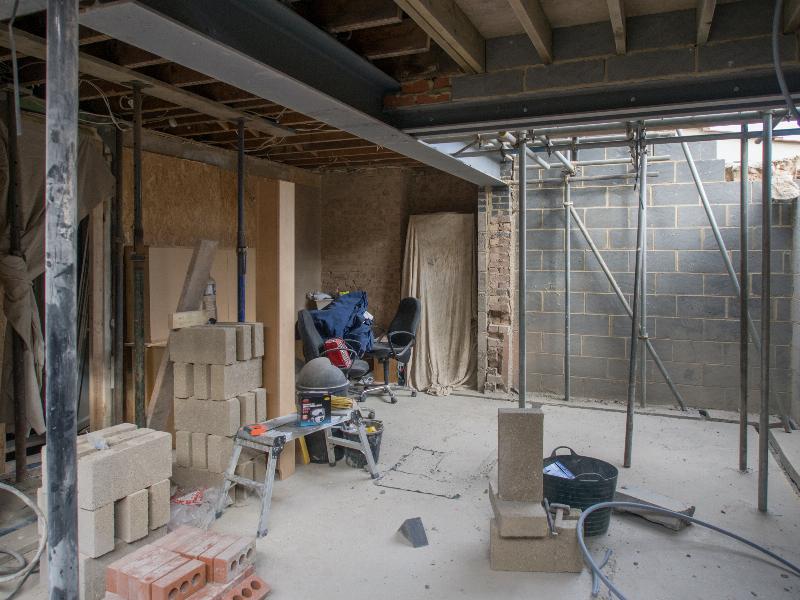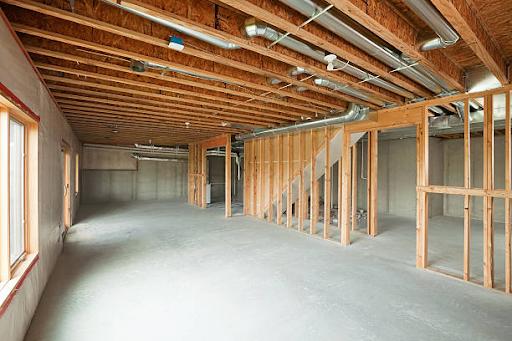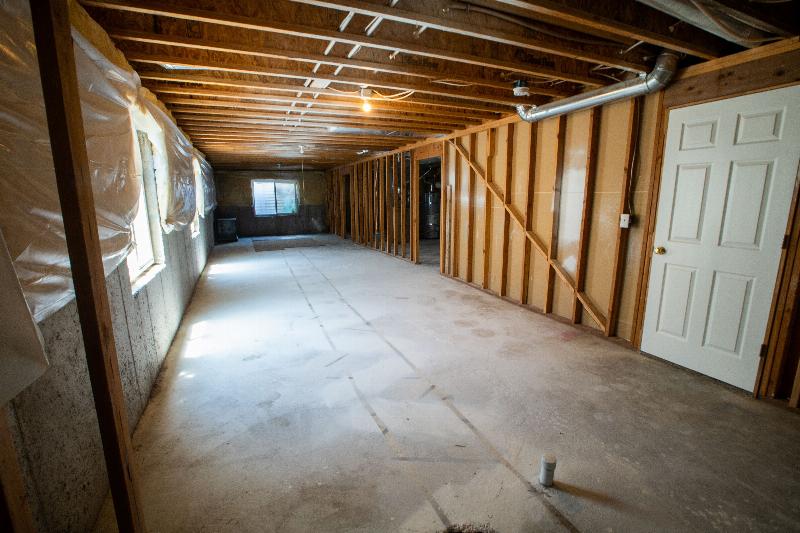Is it possible to raise a basement ceiling?
When utilized, a completed basement may increase the value of any space. Your basement can be transformed into a bedroom, playroom, man cave, etc. Lower basement ceilings can limit the basement’s use and design. It’s difficult to resist the allure of taller ceilings.
You can add height to your existing basement in a variety of ways. Depending on the circumstances, intended effects, budget, and structural integrity of the building, you have two choices: raise the basement floor or raise the basement ceiling. There are other ways that are used to increase your total height.
| Cutting beams | Raising beams |
|---|---|
| Lower basement – Bench Footing | Lower basement – Underpinning |
| House and roof-raising |
|
Cutting Beams
Assume a wood load-bearing beam is obstructed. obstructing the entryway and the joists on the floor sitting on the beam (like many older homes). It is possible to cut the beam, install a new piece at the floor joist level, and re-support the joists using hangers.Beam ends must be re-supported with columns and pad footings.
Raising beams
Let’s say you want to create a nice open space, but there’s that annoying beam right in the middle. How do you divide a space when you don’t want to build walls? It’s possible to raise the entire beam. It’s like the cutting beam method. Except you now raise the entire beam. Raise with all the floor joists butted against the beam with joist hangers.
Of course, the beam ends would have to be supported as well. This will only work if the joists are already on top of the wood beam.
Bench footing in the lower basement
This is the start of the adventure. The only option may be to lower the basement, which can be very expensive If done, it may have major structural effects.
The general advice is to excavate at least 8-10 inches deeper than the level at which your intended lowered floor should rest. For example, if you need to lower your basement floor by 6 inches, dig 14 to 16 inches deep.
You can improve your basement in two ways: with a bench footing or with underpinning. Most of the time, the first one costs less. With this method, a bench will be built around the foundation. It works best in basements that are at least 1,000 square feet. (Tornado plumbing and drain 2021).
Benching
When a basement is benched, a concrete bench is built on a stable excavation slope.
It’s used to lower a basement floor without lowering the foundation footings. So, nothing is done to change the footings that are already there. Keep an excavation slope below the foundation footing. At the top of the slope, a concrete “bench” is built to protect people. It is made of rebar and concrete, and it goes all the way around the inside of the building.
Step-by-step instructions and guidelines
- Take up the floors made of concrete.
- Dig up the soil until it is at the right level. How far the concrete sticks out from the wall will depend on how high the wall needs to be.
- If you lower the basement by 1 foot, the concrete bench should stick out 1 foot to 1 foot and a half from the inside wall.
- After digging out the area for the bench, the edge should be made.
- Putting in the new pipes If the plumbing is not at the same level, use a sewer injector
- Install the drainage system inside your house to make it watertight.
- Put at least 3 inches of 34-inch gravel on the floor to make the base.
- Finish the trowel after the new concrete floor has been laid.
The disadvantage of benching is that it reduces usable space per square foot. In bigger basements, homeowners generally integrate this into the decor. It is critical to understand that the lower you go, the deeper your bench becomes.
Some homeowners bench half the basement while underpinning the other. This may be possible, but you’ll need local engineering design and construction help.
The underpinning of the lower basement
This is the most common method for increasing basement ceiling height. Underpinning a basement is the process of excavating the floor to add depth to your basement. The concrete footings, as well as the gravel and dirt beneath the footings, are removed. It takes a long time to do it right because it is a laborious process. The work will progress step by step, adding support as it goes. The voids are then filled with new gravel and poured concrete to form new foundations.
As you might expect, it is the more expensive option due to the complexity of the task. In effect, it provides you with a new, lower floor, raising your ceiling.
There are three parts to this technique application that must be done in a certain order. Some parts are 3 to 4 feet wide and 2 to 3 feet deep. The soil conditions cause such differences.
Pro tip takeaway: everything relies on the house’s foundation, material, and density.
Due to the building’s foundation, undermining must be done in small sections. This is why the three-stage method is used. When the steps are done in the right order, the basement is lowered in a safe and controlled way. With this method, the structure of the house doesn’t move or settle.
The underlying process is made up of the following steps:
- First, the concrete floor must be taken up and the ground must be dug out to the right level.
- Following the engineer’s drawings, there are three steps to take to remove the pins.
- If the new posts need them, put in new footings. To start, the beam will be held up by short-term jacks.
- When the first stage is done, there will be a gap of 2 inches between the footings and the concrete. So, a dry pack of grout of 2 inches should be used.
- After the first three steps have been completed, put in the new plumbing. If the plumbing heights don’t match, you need a sewer injector.
- If you want to keep water out of your home from the inside, you’ll need to build a drainage system.
- Lay at least 3 inches of gravel on the floor to make the foundation.
- Put down the new concrete floor after you’re done with the trowel.
Pro tip takeaway: Unsafe underpinning might cause your property to collapse. It should only be completed by trained and qualified professionals.
Why should you underpin your basement?
You can make your ceiling higher and add light to the room. Problems with the structure of the foundation will be fixed. You can get more benefits from underpinning as well. You might be able to get heated floors and big windows for your basement. You can also set up your own place to work out there.
Raising the house (and roof)
In this scenario, the house is raised from the sill plate on the foundation wall. This is most likely only workable for wood-framed structures. Masonry homes are expensive. Many things in the house need to be unplugged and plugged back in. (i.e., gas, vents, wiring, pipework, etc.)
The first step in a house lift is to separate the structure from its foundation. This involves disconnecting the home’s electricity, water, and HVAC systems. Once separated, the rest of the lifting is completed by a team of professional house lifters. Attach the home on temporary steel I-beams and jack it up. The team will add structural cribbing underneath the house as it rises to support the weight. To have an adequate area to work, they elevate the home 1-2 feet.
Replace the foundation to guarantee the structure’s stability. This sort of job requires a skilled concrete crew. When the foundation is finished, the lift team will lower the house back onto it and reattach it. (2017 suite additions)
The following are some other minor solutions that may help with minor height issues:
Changes in duct size
Some ducts can be resized (and still provide enough air circulation). You may need to elevate them since they dangle below the joists.
Ductwork relocation
If you can’t reduce the size of the ducts, you may move them to the house’s perimeter.
Putting up barriers
Lower beams and ducts may be used as partition walls. This lowers them.
| Make your room look brighter and sharper. | Hiring a remodeling specialist to restore your basement ceiling will improve its appeal. The ceiling may be brightened by covering it with drywall or tiles in a light hue that reflects more light. |
|---|---|
| To Define Various Basement Areas | Attractive finishes and trim may separate a basement’s living, cooking, and dining areas. A truncated ceiling adds beauty to a basement, but painted ceilings might divide it. |
| Prevent the accumulation of dust and cobwebs. | If the basement ceiling is a source of dust and dirt, insulate it. Add robust drywall or tiled ceiling to protect the room while also completing it. |
| Basement soundproofing has been improved. | To improve basement privacy, insulate or soundproof the ceiling. |
There will be no strapping.
Depending on fire and acoustic rating standards, you may be able to apply drywall without strapping, saving an inch. Investing in the basement ceiling may make the downstairs more practical and attractive. In truth, there are several advantages to remodeling the basement ceiling.
Don’ts for the Basement Ceiling
There are two things you should never do if you want to raise the height of your basement ceiling. If you try these methods, you could damage the structure of your house, which would cost you thousands to fix.
Do not lift or move floor joists or beams to make the room taller. If you do this, you will damage the flooring upstairs.
Do not tear up the floor of your basement to get a few extra inches. Even though it was poured last, the basement slab gives the building support on the sides.
Ready To Remodel Your Basement?
Keep up the good work now that you know how to raise your basement ceiling height! Browse our basement remodeling gallery for ideas.
To begin with, every great basement remodel requires a great design. Use the email address to schedule a free basement design consultation. We’ll take you step-by-step through the basement renovation process. Request a free consultation now! Houston’s best advice is at 832-808-8889 “Smart Remodeling LLC”









